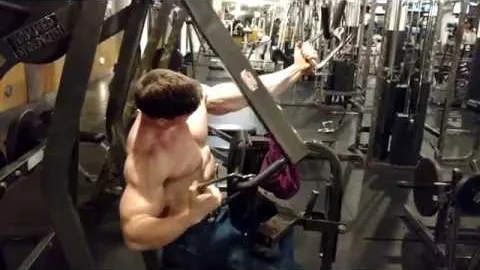Introduction to Angled Pulldown Exercise
The angled pulldown exercise is a highly effective back workout that primarily focuses on the latissimus dorsi muscles, commonly known as the lats. Incorporating this exercise into your fitness routine can help you strengthen and develop your upper back, improve your posture, and increase your overall pulling strength.
In this article, we will provide a detailed guide to the angled pulldown exercise, explaining how to perform it correctly, the muscles targeted, its benefits, and variations that you can incorporate into your workout routine.
How to Perform the Angled Pulldown Exercise
- Start by adjusting the seat and weight stack of the pulldown machine. Sit on the seat with your feet firmly planted on the ground and grasp the overhead bar with a wide, overhand grip.
- Engage your abdominals and maintain a straight posture throughout the exercise. Avoid using momentum or swinging your body to complete the movement.
- Begin the exercise by pulling the bar down towards your upper chest. Focus on squeezing your shoulder blades together as you pull.
- Once the bar reaches your upper chest, pause for a moment and squeeze your back muscles.
- Slowly return the bar to the starting position, allowing your shoulders to fully extend and stretch the lats.
It is important to note that proper form is crucial in order to reap the maximum benefits of this exercise. If you are unsure about how to perform the angled pulldown exercise correctly, consider seeking guidance from a certified fitness professional.
Muscles Targeted by the Angled Pulldown Exercise
Primary muscles targeted by the angled pulldown exercise include:
- Latissimus Dorsi (Lats): As the largest muscles of the back, the lats are responsible for adducting, extending, and internally rotating the shoulder joint. The angled pulldown exercise effectively engages and strengthens these muscles, leading to a wider, more defined back.
- Rhomboids: Located between the shoulder blades, the rhomboids play a crucial role in retracting and stabilizing the shoulder blades. Performing the angled pulldown exercise targets these muscles, which are important for maintaining good posture.
- Trapezius: The trapezius muscles run from the base of the skull to the middle of the back. They are responsible for shoulder elevation, retraction, and depression. The angled pulldown exercise helps to strengthen and develop the upper fibers of the trapezius.
Benefits of the Angled Pulldown Exercise
- Increased Back Strength: Regularly incorporating the angled pulldown exercise into your workout routine can significantly improve your pulling strength, making everyday activities such as lifting objects and carrying groceries easier.
- Improved Posture: The angled pulldown exercise targets the muscles responsible for maintaining good posture, such as the rhomboids. Strengthening these muscles can help correct postural imbalances and alleviate back pain caused by poor posture.
- Enhanced Back Aesthetics: The angled pulldown exercise targets the lats, which are often referred to as the "wings" of the back. By engaging and developing these muscles, you can create a wider, more defined back, enhancing your overall physique.
- Versatile Exercise: The angled pulldown exercise can be easily modified to suit various fitness levels and goals. You can adjust the weight, grip width, or even perform single-arm variations to challenge your muscles in different ways.
- Increased Upper Body Stability: In addition to strengthening the back muscles, the angled pulldown exercise also engages the stabilizing muscles of the shoulder girdle, improving overall upper body stability and coordination.
Variations of the Angled Pulldown Exercise
To keep your workouts engaging and prevent plateaus, you can try out different variations of the angled pulldown exercise. Here are a few popular variations:
- Reverse Grip Pulldown: Instead of using an overhand grip, switch to an underhand grip. This variation places more emphasis on the biceps and forearms while still engaging the back muscles.
- Single-Arm Angled Pulldown: Perform the exercise using one arm at a time. This variation targets each side of the back individually, helping to address any muscle imbalances.
- Wide-Grip Angled Pulldown: Adjust the grip wider than shoulder-width apart. This targets the outer portion of the lats, creating a wider look to the back.
- Close-Grip Angled Pulldown: Bring the grip closer than shoulder-width apart. This variation targets the inner portion of the lats, creating a more defined and detailed back.
Conclusion
The angled pulldown exercise is a highly effective movement for strengthening and developing the muscles of your upper back. By incorporating this exercise into your fitness routine, you can improve your pulling strength, enhance your posture, and achieve a more aesthetic back physique. Remember to prioritize proper form and consider trying out the variations mentioned to keep your workouts challenging and engaging. Happy training!
